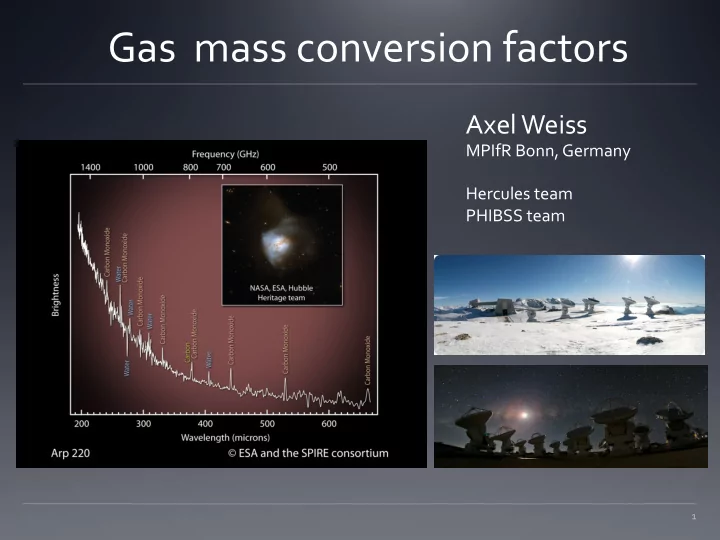

Gas mass conversion factors Axel Weiss MPIfR Bonn, Germany Hercules team PHIBSS team 1
Motivation Daddi ea 2010 Scoville ea 2016 L 850 /L’ CO(1-0) α =0.8 α MW Today we have much better data to reevaluate molecular gas mass conversion factors! (CO SEDs, good dust continuum coverage, information from other lines like CI in larger samples of galaxies) 2
Cold H 2 in action - collisions by H 2 are directly observable ! ‘Hot Boltzmann tail’ Multi-component ISM versus 10 3 cm -3 500-2000K 10 4 cm -3 10 5 cm -3 3
Non-LTE line + dust radiative transfer analysis N(H 2 ) / dv ~ n(H 2 ) δ v/ δ r -1 *[mol]/[H 2 ] => line opacity Parameters: N(H 2 ) = N(H 2 ) / dv dv turb * GDMR => dust opacity Physical M(H 2 ) = Ω s N(H 2 ) H 2 density • kinetic temperature • (Weiss ea 2007) turbulence δ v/ δ r; dv turb ; δ v/ δ r ~ sqrt( n(H 2 ) ) • size of the emission region ( Ω s b ff = π r 0 2 ) • Dust and gas are linked at Chemical several levels: [mol]/[H 2 ] • - dust is background for lines Gas to dust mass ratio (GDMR) • - gas columns from lines linked to dust opacity - Tkin >= 0.5*Tdust Radiation Field: Background CMB + Dust (T dust β λ τ =1 ) • 4
Turbulent ISM Density distribution is log normal Column density for a turbulent ISM (simulation) T kin ~ n(H 2 ) - γ ( hydro sim) low dv turb high dv turb Distribution: n(H 2 ), T kin T dust Ω , [ CI] Numbers: dv turb κ vir GDMR, [CO] e.g. Krumholz & McKee 2005, Goldbaum ea 2016 5
Exponential turbulent Disk Distribution: Σ gas (r) => n(H 2 ) (r) T kin T dust, Ω Numbers: dv turb κ vir chemical params Each component is the result from the turbulence model with <n(H 2 )> , <T kin > and Ω source from the exponential disk distribution 6
Sample and Diagnostics Hercules : local (U) LIRGs 26 galaxies CI for 21 Rosenberg ea 2015 High-z QSOs and SMGs (submm selection, above the MS) z=2.0 – 6.3 6 SBs; 6 QSO hosts CI: 8 e.g Weiss ea 2005, 07 Walter ea 2011 9 High-z MS galaxies 2 comp. (z~2, NIR selection) Log M * = 10.5- 11.8 CI: 4 turb. Daddi ea 2010/15 Tacconi ea 2013 Genzel ea 2015 turb. disk Total 44 (U)LIRG 7
CO conversion factor for the MW Calibration for inner part of the MW ( |2.5| < l < |32.5|) Planck, IRAS (Fixsen ea 1999) (Fixsen ea 1999) 2C: α co = 4.0 +/- 1.1 M sol (K km/s pc 2 ) -1 T: α co = 4.9 +/- 1.9 M sol (K km/s pc 2 ) -1 TD: α co = 4.0 +/- 0.7 M sol (K km/s pc 2 ) -1 X co = 1.9 +/- 0.3 x 10 20 cm -2 ( K km/s) -1 (Incl. He correction) Bolatto ea 2003 8
The conversion factors: (turbulent disk model; preliminary) α CO α CI α 850
Test case GN20 Turbulent Disk model GN20 @ z =4.05 Hodge ea 2015 CO(2-1) Limits on α co from M dyn : 170 µ m α co < 3.3 M sol (K km/s pc 2 ) -1 rest continuum we find: α co : 2.2 +/ -0.8 M sol (K km/s pc 2 ) -1 Radial profile model (example) vs observations 10
Disk sizes for different tracers Turbulent Disk model SMM14011 @ z =2.5 Difference compared to Σ ( H 2 ) implies that ALL conversion factors change with r! 11
Recommend
More recommend